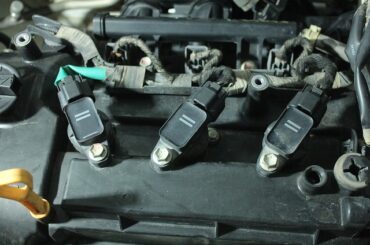Contents
Spare Tire Stuck in Trunk
The convenience of having a spare tire in your vehicle’s trunk for emergencies is undeniable, but what happens when that lifesaver is the one in distress? A common and often perplexing issue faced by many vehicle owners is a “Spare Tire Stuck in Trunk.” It’s a situation that not only causes inconvenience but can also raise concerns about safety and preparedness when you need it the most.
Inconvenience and Safety Concerns
A spare tire stuck in the trunk is a source of immense inconvenience. Whether you’re dealing with a flat tire on the roadside or an urgent situation where a functional spare is vital, discovering that your spare tire is inaccessible can be exasperating. In such scenarios, every moment counts, and being able to swiftly access your spare tire is of paramount importance.
Moreover, safety is a critical aspect of this issue. When you’re stranded on the road due to a punctured tire, ensuring your safety and that of your passengers is a top priority. A stuck spare tire can significantly prolong the time spent on the roadside, increasing the risk of accidents or further complications.
This article delves into the common problem of a “Spare Tire Stuck in a Trunk” and offers insights into the causes and solutions to this frustrating situation. We will guide you through the steps to free a stuck spare tire and provide preventive measures to avoid it in the future, ensuring that you are prepared for the unexpected with a readily accessible spare tire.

Understanding the Issue
When a spare tire becomes stuck in the trunk of your vehicle, it’s a problem that can leave you feeling helpless and frustrated. To effectively address this issue, it’s crucial to understand why it happens and what causes a spare tire to get jammed in the trunk. Here, we’ll explore the common causes, the significance of prompt resolution, and the importance of understanding the issue.
Common Causes
Rust and Corrosion: One of the most prevalent causes of a spare tire getting stuck is rust and corrosion. Over time, especially in regions with harsh climates or exposure to road salt, the mechanism that secures the spare tire in place can become corroded. This corrosion can cause the spare tire’s release mechanism to seize, preventing it from lowering.
Improper Storage
Sometimes, spare tires are stored in a way that makes them prone to getting stuck. If a spare tire is rarely removed or checked, it can become wedged in place due to its weight and the pressure applied over time. This can happen when the tire is stored with too much force pressing it against the trunk’s ceiling.
Inadequate Maintenance: Neglecting the spare tire and its storage area can lead to problems. Lack of regular maintenance can result in the accumulation of debris, dirt, or even small objects around the release mechanism, obstructing its operation.
Importance of Prompt Resolution
The importance of promptly addressing a spare tire stuck in the trunk cannot be overstated. When you’re facing a flat tire or any other roadside emergency, quick access to the spare tire can make a significant difference in your safety and the timely resolution of the situation. Delays caused by a stuck spare tire can expose you to increased risks, especially if you’re on a busy road or in adverse weather conditions.
Moreover, a prompt resolution can prevent further damage to the vehicle. Struggling to force the spare tire free can result in damage to the trunk or the tire itself, leading to additional repair costs.
The First Step to a Solution
Understanding the issue is the initial step in finding a solution. By comprehending the common causes of a spare tire getting stuck and the consequences of not addressing it promptly, you’ll be better equipped to tackle the problem and ensure that your spare tire remains accessible when you need it most. In the following sections, we will guide you through the steps to release a stuck spare tire and provide preventive measures to avoid this issue in the future.
Steps to Free a Stuck Spare Tire
When your spare tire is stuck in the trunk, it can be a frustrating situation. However, you can usually free it with some straightforward steps. Here’s a step-by-step guide on how to release a stuck spare tire:
1. Remove Obstructions:
Before attempting to release the spare tire, check for any items or objects that may be blocking its release. It’s not uncommon for luggage, tools, or other cargo to obstruct access to the spare tire.
2. Locate the Release Mechanism:
The spare tire in most vehicles is secured in place with a release mechanism. This mechanism is often located beneath the trunk’s floor, typically in the center or rear part of the trunk area. Refer to your vehicle’s owner’s manual to identify the exact location of the release mechanism.
3. Use the Lug Wrench:
If your spare tire is secured with a bolt, you may need to use the lug wrench or a tool provided in your vehicle’s toolkit to loosen and remove the bolt. The lug wrench typically fits the bolt, allowing you to turn it counterclockwise to release the spare tire.
4. Check for Secondary Latches:
Some vehicles have a secondary latch to prevent the spare tire from falling when the primary release mechanism is activated. Once the spare tire is loosened, check for any secondary latches that may be holding it in place. You need to ensure these are released to completely free the tire.
5. Lower the Spare Tire:
Once you’ve released the spare tire, it should be ready to be lowered from its secured position. Be cautious when doing this, as spare tires can be heavy. Slowly lower the spare tire to the ground.
6. Exercise Caution:
It’s important to exercise caution while performing these steps, especially when dealing with heavy spare tires. Take your time, ensure the area is clear, and avoid any sudden movements that might lead to accidents or injuries.
By following these steps, you should be able to release a stuck spare tire from the trunk of your vehicle. Remember that specific details and the location of the release mechanism may vary depending on your vehicle’s make and model, so always consult your owner’s manual for precise instructions.
Common Causes and Solutions
Understanding the common causes behind spare tires getting stuck in trunks is the key to preventing this frustrating issue. Here, we’ll delve into these common causes and provide practical solutions and preventive measures for each of them:
1. Rust and Corrosion:
Cause: One of the primary culprits behind a stuck spare tire is rust and corrosion, which can affect the release mechanism over time. This is especially prevalent in regions with harsh climates or where road salt is frequently used.
Solution: To address this issue, consider using rust-penetrating lubricants on the release mechanism and any associated parts. These lubricants can help loosen and dissolve rust, making it easier to release the spare tire. Apply the lubricant regularly to prevent future corrosion.
2. Improper Storage:
Cause: Spare tires that are stored improperly are more likely to get stuck. If the spare tire is pressed against the trunk’s ceiling or sidewalls with excessive force, it can become jammed.
Solution: When storing the spare tire, make sure it is positioned securely in its designated location without excessive force. Check the owner’s manual for your vehicle to ensure you’re storing the spare tire correctly.
3. Inadequate Maintenance:
Cause: Neglecting the maintenance of the spare tire and its storage area can lead to debris, dirt, or small objects accumulating around the release mechanism. These obstructions can hinder the mechanism’s operation.
Solution: Regularly inspect and clean the area around the spare tire and its release mechanism. Remove any debris, dirt, or small objects that could potentially obstruct the release. Keep this area clean and free of obstructions to ensure easy access to the spare tire when needed.
4. Proper Lubrication:
Cause: Lack of proper lubrication can also lead to a spare tire getting stuck over time. Without adequate lubrication, the release mechanism can become stiff and difficult to operate.
Solution: Apply a suitable lubricant to the release mechanism as part of your regular maintenance routine. This will keep the mechanism operating smoothly and reduce the chances of the spare tire getting stuck.
By understanding these common causes and applying the respective solutions and preventive measures, you can significantly reduce the risk of your spare tire becoming stuck in the trunk. Regular maintenance, proper storage, and the use of rust-penetrating lubricants are key practices to ensure that your spare tire is always accessible when you need it.

When to Seek Professional Help
While many cases of a stuck spare tire can be resolved using the steps and solutions mentioned earlier, there are situations where professional assistance may be necessary. It’s essential to recognize when it’s time to call in a mechanic or contact your vehicle manufacturer’s customer service for help. Here’s when to seek professional assistance:
1. Excessive Stuckness:
If the spare tire is excessively stuck, despite following the recommended steps and using lubricants, it’s advisable not to force it free. Forcing the spare tire can lead to damage or further complications.
2. Damaged Release Mechanism:
If you suspect that the release mechanism itself is damaged or malfunctioning, attempting to resolve the issue without professional assistance may cause further harm. A mechanic or technician can diagnose and repair a damaged release mechanism correctly.
3. Safety Concerns:
If you’re in a situation where your safety is compromised, such as being on a busy road, in adverse weather conditions, or facing other hazards, seeking professional help is crucial. Your safety should be the top priority, and waiting for a professional to arrive is often the safest course of action.
4. Complex Release Mechanism:
Some vehicles have complex release mechanisms that require specialized knowledge and tools to operate. If you’re unfamiliar with the mechanism or unable to release the spare tire with standard methods, it’s best to contact a professional.
5. Vehicle-Specific Issues:
If you’re driving a newer vehicle with unique features or technology, the release mechanism or spare tire storage may be different from standard setups. In such cases, the expertise of a mechanic familiar with your vehicle model may be required.
Recommendation
When you encounter any of these situations, it’s recommended to contact a qualified mechanic or your vehicle manufacturer’s customer service. They have the expertise and the necessary tools to address complex issues and ensure that the spare tire is released without causing any damage to your vehicle or compromising your safety. Remember that safety should always be your top concern, and seeking professional help when needed is a responsible and cautious approach to resolving the problem.
Preventive Maintenance
Preventive maintenance plays a crucial role in ensuring that your spare tire remains easily accessible and functional in the future. By taking proactive steps and following these tips, you can avoid spare tire issues and be well-prepared for any unexpected situations:
1. Regular Inspection:
Make it a habit to inspect your spare tire and its storage area periodically. Regular inspection can help you identify issues early on.
2. Clean the Area:
Keep the area around the spare tire clean and free of debris. Dirt and small objects can accumulate around the release mechanism, hindering its operation. Regular cleaning will prevent obstructions.
3. Lubrication:
As part of your routine maintenance, apply a suitable lubricant to the spare tire release mechanism. Proper lubrication ensures that the mechanism operates smoothly and prevents rust and corrosion from developing.
4. Proper Storage:
When storing the spare tire, make sure it’s secured correctly in its designated location. Avoid applying excessive force that could potentially jam the tire. Consult your owner’s manual to ensure you’re storing the spare tire properly.
5. Maintain Correct Tire Pressure:
Check the air pressure in your spare tire regularly to ensure it’s inflated to the recommended pressure. Adequate tire pressure is vital for its functionality when needed.
6. Periodic Rotation:
If your spare tire is a full-size spare, consider rotating it with your other tires during regular tire rotations. This helps prevent the spare tire from developing flat spots and ensures it’s always in good condition.
7. Replacement Schedule:
Spare tires have a limited lifespan, even if they are rarely used. Check your owner’s manual for information on the recommended replacement schedule for your spare tire. Over time, spare tires can deteriorate, so having a fresh spare is essential.
8. Emergency Kit:
Along with your spare tire, it’s a good idea to keep an emergency kit in your vehicle. This kit can include tools, a flashlight, gloves, and other items that may come in handy during a roadside emergency.
By following these preventive maintenance tips, you can ensure that your spare tire remains in excellent condition and easily accessible when needed. Regular inspections, proper storage, and maintenance will contribute to your peace of mind, knowing that you’re well-prepared for any unexpected situation on the road.

Conclusion
In the world of automotive inconveniences, few situations can be as exasperating as discovering that your spare tire is stuck in the trunk precisely when you need it most. This article has delved into the perplexing issue of a “Spare Tire Stuck in Trunk,” shedding light on the common causes and offering practical solutions to ensure that your spare tire remains accessible and your vehicle is prepared for unexpected road emergencies.
Summarizing Key Points:
We explored the common causes behind a spare tire getting stuck in the trunk, emphasizing issues such as rust and corrosion, improper storage, and inadequate maintenance.
Practical solutions and preventive measures were provided for each of these causes, including the use of rust-penetrating lubricants, proper storage, and regular maintenance.
Recognizing when to seek professional help was underlined, especially in cases of excessive stuckness, safety concerns, and complex release mechanisms.
The significance of preventive maintenance was highlighted, with tips for routine inspections, cleaning, lubrication, and proper storage to avoid future incidents.
Prompt Resolution and Preparedness:
Addressing the issue of a stuck spare tire promptly is not only a matter of convenience but also a critical aspect of your safety and peace of mind. Understanding the common causes and solutions ensures that you are well-equipped to tackle this frustrating problem.
With the right knowledge and preventive measures, you can ensure that your spare tire is readily accessible and that your vehicle remains safe and reliable. Whether you’re on a long journey or facing an unexpected roadside emergency, the confidence of having a functional spare tire at your disposal is an invaluable asset. By following the recommendations provided in this article, you can make certain that you’re always well-prepared for whatever the road may bring.






